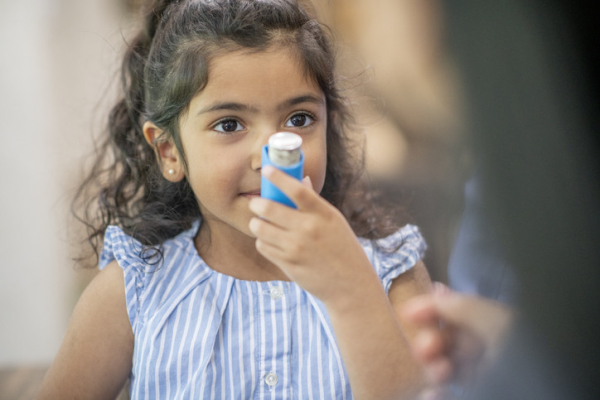
Asthma is the most common chronic lung disease in children. In the US, it affects about 6 million children, or about one in every 12 children.
Breathing is key to life, obviously, so asthma can make life very hard. It can make going for a walk outside feel very hard. It leads not just to visits with the doctor or to the emergency room, and to hospitalizations, but also to missed school, missed work for parents, missed events, and missed activities.
The good news is that asthma is very treatable. If parents, children, and doctors work together, a child with asthma can lead a healthy, normal life. Here’s what you need to know and do.
Know your child’s symptoms
Wheezing is definitely a symptom of asthma, but a dry persistent cough can be as well (for some children, this occurs mostly at night).
Watch for signs that a child is working harder to breathe. One sign is skin tugging inward between, on top of, or below the ribs. Difficulty talking in long sentences is another sign of this.
Some children with exercise-induced asthma avoid exercise; if your child is choosing to be less active, talk to them about why.
Know your child’s triggers
There are many different triggers for asthma, including:
- Upper respiratory infections, like the common cold. COVID falls into this category, which is why children with asthma should be vaccinated against COVID.
- Allergies, such as
- outdoor allergens like pollen, which are often worse in the spring and fall
- indoor allergens like dust mites or mold
- pet dander.
- Exercise. Some children will struggle with even mild exercise, while others only have trouble with vigorous exercise or exercising when there are other triggers too (like a cold or allergies).
- Weather changes, especially to colder weather. Some children can be triggered by going into a cold, air-conditioned room.
- Stress. Stress affects our bodies in multiple ways, and in some people it can trigger their asthma or make it worse.
Understand your child’s medications
Several kinds of medicines are used to treat asthma, including:
- Bronchodilators. Examples are albuterol, levalbuterol, formoterol, or ipratropium. Known as “rescue medications,” these are inhaled and work by opening up the airways. They are given through metered-dose inhalers or a nebulizer machine. They are used when a person is experiencing symptoms.
- Inhaled steroids. These work by decreasing inflammation in the lungs and making them less likely to react to triggers. They are “controller medications” given regularly to prevent symptoms.
- Combined inhalers. These have both an inhaled steroid and a long-acting bronchodilator. They are very useful for patients with more difficult asthma. Sometimes they are used in SMART (Single Maintenance And Reliever Therapy), in which the same inhaler is used for both rescue and control.
- Oral or injected steroids. These are generally used when someone has a bad asthma attack, but some people need to take them regularly to prevent attacks.
- Allergy medications. Medicines like loratadine, cetirizine, or montelukast can be very helpful when there is an allergic component to asthma.
Some people with severe asthma need other treatments, such as allergy shots for severe allergies, or medications like dupilumab that work in the body to flight inflammation. This is far less common.
Use medication correctly
- Sometimes medications and medication regimens can be confusing. That’s why everyone with asthma should have a written Asthma Action Plan that spells out exactly what they should do and when.
- If your child uses an inhaler, make sure that they are doing it right! For most inhalers, it’s important to use a spacer, which is a tube that attaches to the inhaler and helps to ensure that the medication gets into the lungs and not just the mouth or surrounding air.
- If you have any questions about anything your child is prescribed, call your doctor.
Meet with your doctor regularly
If your child’s asthma is anything more than very mild (a few mild attacks a year), you need to check in more frequently than at the yearly checkup. Extra check-ins give you a chance to talk to your doctor about how things are going — and give your doctor a chance to tweak your child’s regimen so that your child can live the healthiest, happiest life possible.
Which, after all, is totally the point.
Follow me on Twitter @drClaire
About the Author

Claire McCarthy, MD, Senior Faculty Editor, Harvard Health Publishing
Claire McCarthy, MD, is a primary care pediatrician at Boston Children’s Hospital, and an assistant professor of pediatrics at Harvard Medical School. In addition to being a senior faculty editor for Harvard Health Publishing, Dr. McCarthy … See Full Bio View all posts by Claire McCarthy, MD
